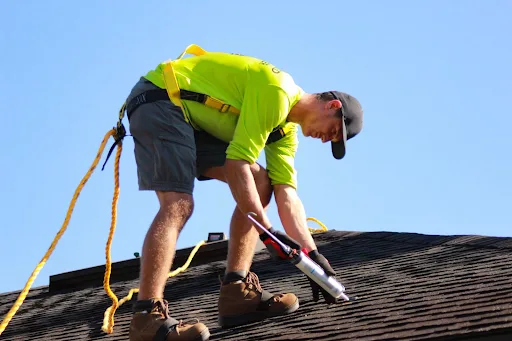4 minute read
Your roof is crucial in protecting your home, so understanding when to replace it is vital for maintaining your property’s value and safety. A complete roof replacement is an investment, and knowing when it’s time to take that step can save you from unexpected damage and expenses. Here’s what you should know to determine if your roof needs a full overhaul.
Extensive Shingle Damage
Shingles are your roof’s first line of defense against the elements. If you notice cracked, curled, or missing shingles across multiple sections, it’s a strong sign that your roof may need replacing. While replacing a few shingles here and there can be a temporary fix, widespread damage often indicates that the underlying structure has been compromised. For extensive shingle damage, look at Distinctive Roofing, where roof repair can restore your home’s protection and enhance its curb appeal. Inspect your shingles regularly, especially after severe weather, to assess their condition.
Age of the Roof
The age of your roof is often a primary indicator of when it might need replacing. Most asphalt shingle roofs, for example, have a lifespan of 20 to 25 years. If your roof is approaching or has exceeded this range, you should start considering a complete replacement. Even if there are no visible signs of damage, an older roof may not provide the same level of protection due to wear and tear over time.
Water Damage and Leaks
Water damage is one of the most serious signs that you need to act quickly. Leaks that penetrate your home’s interior can lead to mold growth, structural damage, and costly repairs. Check your attic and ceilings for water stains or damp spots, as these can be clear signs that your roof is failing to keep moisture out. Persistent or widespread water damage may mean a full roof replacement is necessary to prevent further issues.
Inspect for Mold Growth
Mold thrives in damp environments, and any water intrusion can create the perfect breeding ground for it. If you discover mold in your attic or around roof fixtures, it often indicates that moisture is entering from your roof. Not only can mold pose health risks, but it can also lead to significant structural damage if left untreated, making prompt action essential.
Check Insulation Conditions
Water damage can compromise your attic’s insulation, which plays a critical role in regulating your home’s temperature and energy efficiency. When insulation becomes wet, it loses its effectiveness, leading to increased heating and cooling costs. If you notice damp or sagging insulation, it’s important to evaluate whether a roof replacement is necessary to ensure your home remains energy-efficient.
Evaluate Structural Integrity
Continuous leaks can weaken the underlying structure of your roof, affecting rafters, trusses, and even the walls of your home. If the water damage is extensive, these structural components may need to be replaced as well. A thorough inspection by a roofing professional can help assess the extent of the damage and whether a complete roof replacement is the best solution.
Sagging Roof
A sagging roof is a red flag that requires immediate attention. This could indicate structural issues, such as damage to the supporting beams or a compromised foundation. A roof should appear uniformly straight along its lines – any visible sagging often points to underlying problems that a simple repair can’t fix. Ignoring this sign can lead to severe structural failures, making a complete replacement the safest option.
Higher Energy Bills
An unexpected spike in energy costs could be a sign that your roof is no longer functioning efficiently. Older or damaged roofs often lose their ability to insulate your home properly, causing your heating and cooling systems to work overtime. If you notice your energy bills increasing without any other explanation, have your roof inspected. An energy-efficient replacement could help you save on long-term energy expenses.
Visible Daylight Through Roof Boards
If you can see daylight peeking through the roof boards in your attic, this is a strong indicator that your roof is compromised. This problem shows that your roof’s protective layers have worn thin or are damaged, leaving it vulnerable to further deterioration and potential water intrusion. Immediate action, such as assessing whether a complete roof replacement is necessary, can prevent additional damage to your property.
Recognizing when to replace your roof can help you avoid major issues and save money in the long run. Assessing factors like the age of your roof, extensive shingle damage, water leaks, sagging areas, energy inefficiency, and visible light through roof boards will guide you in making the right decision. If you notice any of these warning signs, consulting with a roofing professional to discuss your options for a complete roof replacement is essential to protect your home and maintain its value.





